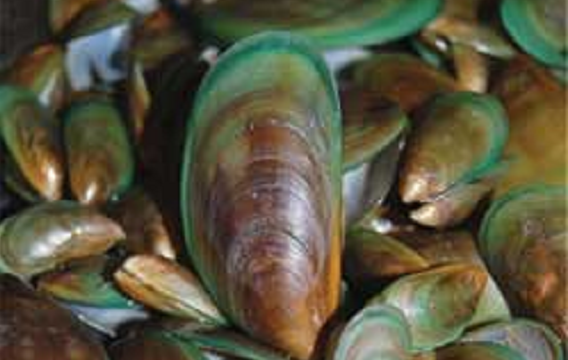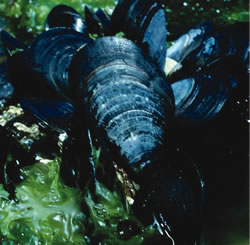Asian green mussel
The Asian green mussel (Perna viridis) is a large, fast growing bivalve known to outcompete native species. This mussel accumulates a high concentration of toxins and heavy metals and if eaten has the potential to cause human-health impacts (shellfish poisoning).
Asian green mussels are transported via vessel hulls, in ballast water and in niche areas such as on ropes and in internal seawater systems. This pest has been detected in Australian waters on internationally arriving vessels several times but has so far been successfully managed and prevented from establishing in the wild.
Preventing the introduction and establishment of this marine pest benefits not only the NSW environment and fisheries, but the shipping industry itself. Vessel owners and managers, vessel inspectors, slipway operators, commercial divers should be on the look-out for non-native marine species, including Asian green mussels on vessel hulls and in niche areas.
The Asian green mussel is listed as prohibited matter under the NSW Biosecurity Act 2015 and is considered a major threat to native fauna and the environment. It is illegal to possess or knowingly introduce into NSW or allowed to escape into any waters in NSW.
Reporting
If you think you have seen an Asian green mussel in NSW, please take several clear, high resolution photos of the mussel from different angles. For identification, we need to see the:
- Shell colour and markings
- Mussel size – please include something for reference (e.g. a coin)
- Photo of the open shell if possible
Please send photos to aquatic.biosecurity@dpi.nsw.gov.au, along with details of when and where the mussel was seen. Please note if the mussel was found as a clump of individuals.
If you can collect a sample, seal it in a plastic bag and refrigerate it or keep it on ice and let us know in your report.
Identification

Key features
- Juveniles - bright green shell
- Adults - dark green to brown shell, may have green edges to shell
- Adults commonly 8-10cm in length, can reach up to 16cm in length
- Shell outside smooth with evenly spaced (concentric) grooves
- Inside shell is smooth and pearly
Known locations
- Not established in Australia
- Has previously been recorded in Cairns and Weipa QLD but no populations are known to exist in the environment
- Previous detections on several internationally arriving vessels in Australian waters
Habitat
- Variety of hard surfaces, particularly floating, including vessels, wharves, buoys, intake pipes, aquaculture equipment
- Low tide to 42m depth, lower estuarine habitats to marine
- Tropical to warm waters but tolerates wide ranges of salinities and temperatures
Vectors
- Vessels
Impacts
- Fast growing, out-competes native species
- Forms dense clumps, fouls man-made structures
- Accumulates toxins and is linked to shellfish poisoning in humans
Similar native species
Blue mussel (Mytilus galloprovincialis planulatus)

Key features:
- Large fan shaped shell up to 12cm
- Blue/black colour
- Usually found in clumps
Habitat:
- Sheltered and moderately exposed reefs, pylons and pontoons
- Up to 15m depth